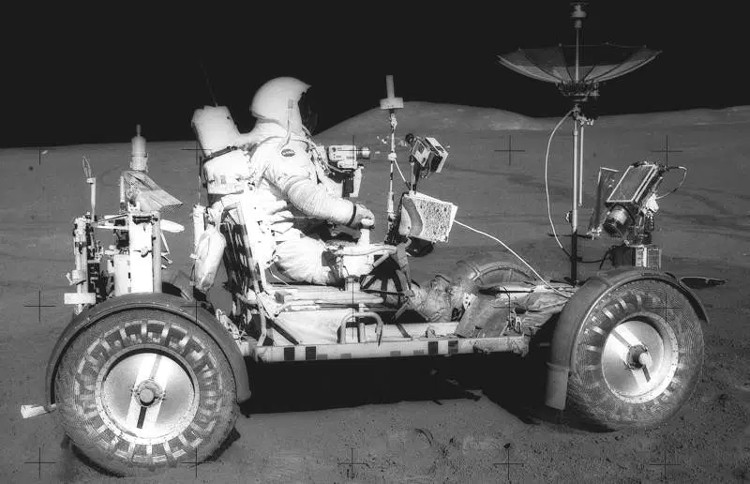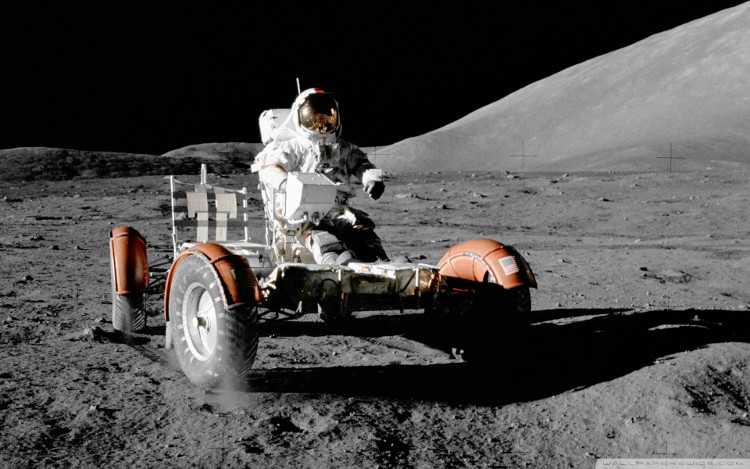Three electric cars used to roll on the Moon
NASA cars in missions Apollo 15, 16 and 17 are left on the Moon's surface after use.
The event SpaceX launched into space was equal, on February 7 attracted much attention. However, this is actually not the first electric car to be brought to space.
The title belongs to NASA's Lunar electric vehicle in the Apollo 15 mission in 1971, the International Business Times reported on February 10. Later, NASA continued to bring two other electric vehicles to the Moon in Apollo 16 and Apollo 17 missions.
Mission Apollo 15

Astronaut David Scott controls electric vehicles on the Moon in 1971. (Photo: NASA).
During the Apollo 15 mission, astronauts David Scott and James Irwin, for the first time, used specialized vehicles on the Moon to collect soil samples and bring them to study.
The car is battery-powered, weighing nearly 210kg on Earth but only about 35kg on the Moon. It passes a total of 27.8km in over three hours of activity on the Moon.
Mission Apollo 16
Apollo 16 was the space mission that took the spacecraft to land on the Moon for the fifth time and was the first landing in the plateau. NASA built a completely new car for this task. After landing on the Moon, two and Charles Duke drove the car for a total of about 3.5 hours, traveling over a distance of more than 26 km.
Mission Apollo 17

The last electric car runs on the surface of the Moon.(Photo: NASA).
The third and final car to land on the Moon is now used in the Apollo 17 mission in 1972. The astronauts Eugene Cernan and Jack Schmitt used this vehicle to explore the Moon. They traveled a total of 35.9 km with a driving time of 4 hours 26 minutes.
"The Moon Car has proven it to be a reliable, safe and flexible Moon exploration vehicle as we expected. Without this car, we won't be able to get big scientific findings. in the mission Apollo 15, 16, 17 as well as the current understanding of the development of the Moon, " Schmitt said.
- Electric cars that once shone 100 years ago, die now and will explode in the future
- Van electric cars with design from the future
- Students make an electric car that runs 900km on a single charge
- Electric cars are wrapped around the pillow
- Electric cars can be miniaturized
- Cambodia itself produces electric cars, cost less than 200 million
- Electric cars are more polluting than gasoline vehicles
- Video: How have cars changed in the last 100 years?
- Indian electric car charger once ran 100km
- The world's first electric car model in the US parliament house
- Electric cars can cause environmental problems
- Era trend: Electric vehicles run
 Van Allen's belt and evidence that the Apollo 11 mission to the Moon was myth
Van Allen's belt and evidence that the Apollo 11 mission to the Moon was myth The levels of civilization in the universe (Kardashev scale)
The levels of civilization in the universe (Kardashev scale) Today Mars, the sun and the Earth are aligned
Today Mars, the sun and the Earth are aligned The Amazon owner announced a secret plan to build a space base for thousands of people
The Amazon owner announced a secret plan to build a space base for thousands of people What would a day on the Moon be like for astronauts?
What would a day on the Moon be like for astronauts?  First photo of Mars' strangely shaped moon
First photo of Mars' strangely shaped moon  The biggest supermoon of the year is about to light up the world's skies
The biggest supermoon of the year is about to light up the world's skies  New research shows that Earth has a new 'Moon'
New research shows that Earth has a new 'Moon'  James Webb Telescope Discovers Rare Scene From Saturn's Moon
James Webb Telescope Discovers Rare Scene From Saturn's Moon  Shock Detected on the Dark Side of the Moon: Structure Identical to Earth!
Shock Detected on the Dark Side of the Moon: Structure Identical to Earth! 